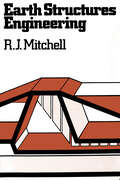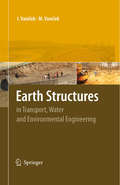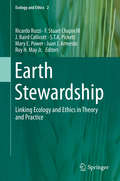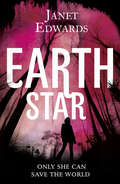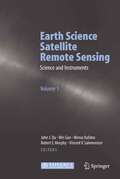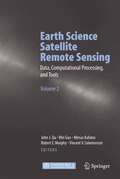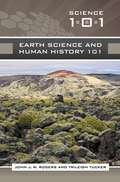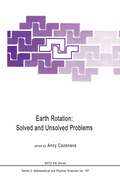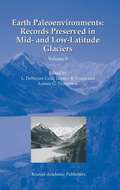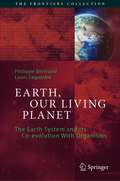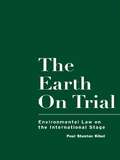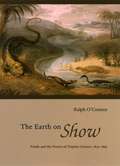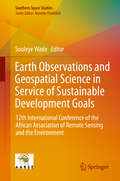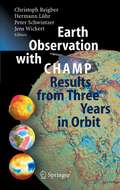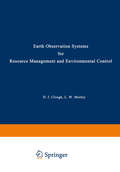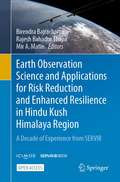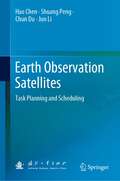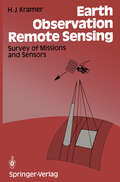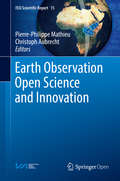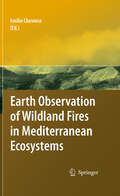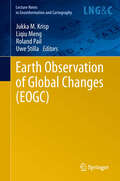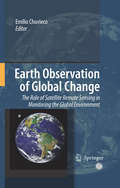- Table View
- List View
Earth Structures Engineering
by R. MitchellEarth structures engineering involves the analysis, design and construction of structures, such as slopes and dams, that are composed mainly of earth materials, and this is a growth area in geotechnical engineering practice. This growth is due largely to increased involvement in designing various types of earth structures for the resources industries (slopes, impoundment structures, offshore islands, mine backfills), to the development of increas ingly large hydroelectric projects, to the need for more freshwater storage and diversion schemes, and to the need for transportation, communications and other facilities in areas where the natural earth materials are occasionally subject to mass instabilities. Although geotechnical engineering transects traditional disciplinary boundaries of civil, geological and mining engineering, the majority of geotechnical engineers are graduates from civil engineering schools. Here the geotechnical instruction has been concentrated on soil mechanics and foundation engineering because foundation engineering has traditionally been the major component of geotechnical practice. Geotechnical special ists, however, generally have acquired considerable formal or informal training beyond their first engineering degree, and an advanced degree with considerable cross-discipline course content is still considered an advantage for a young engineer entering a career in geotechnical engineering. Practical job experience is, of course, a necessary part of professional development but is readily interpreted and assimilated only if the required background training has been obtained.
Earth Structures: In Transport, Water and Environmental Engineering
by Ivan Vanicek Martin VanicekSoil represents the oldest and most-used building material, yet up to now the subject of earthen structures has not been fully addressed. This book describes the principles of soil as construction material including its treatment using geosynthetics and stabilization. The book focuses on the principles, logic of processes, understanding of the most important problems, so that all participants in the construction project can build earth structures more safely and economically.
Earth Stewardship: Linking Ecology and Ethics in Theory and Practice (Ecology and Ethics #2)
by Ricardo Rozzi F. Stuart Chapin III J. Baird Callicott S.T.A. Pickett Mary E. Power Juan J. Armesto Roy H. May Jr.This book advances Earth Stewardship toward a planetary scale, presenting a range of ecological worldviews, practices, and institutions in different parts of the world and to use them as the basis for considering what we could learn from one another, and what we could do together. Today, inter-hemispheric, intercultural, and transdisciplinary collaborations for Earth Stewardship are an imperative. Chapters document pathways that are being forged by socio-ecological research networks, religious alliances, policy actions, environmental citizenship and participation, and new forms of conservation, based on both traditional and contemporary ecological knowledge and values. “The Earth Stewardship Initiative of the Ecological Society of America fosters practices to provide a stable basis for civilization in the future. Biocultural ethic emphasizes that we are co-inhabitants in the natural world; no matter how complex our inventions may become” (Peter Raven).
Earth Star
by Janet EdwardsThe highly anticipated follow-up to Janet Edward’s sensational YA sci-fi debut, Earth Girl.
Earth Science Satellite Remote Sensing: Vol.1: Science and Instruments
by John J. Qu Wei Gao Menas Kafatos Robert E. Murphy Vincent V. SalomonsonThis book provides information on the Earth science remote sensing data information and data format such as HDF-EOS. It evaluates the current data processing approaches and introduces data searching and ordering from different public domains. It further explores the remote sensing and GIS migration products and WebGIS applications. Both volumes are designed to give an introduction to current and future NASA, NOAA and other Earth science remote sensing.
Earth Science Satellite Remote Sensing: Vol.2: Data, Computational Processing, and Tools
by John J. Qu Wei Gao Menas Kafatos Robert E. Murphy Vincent V. SalomonsonThis book provides information on the Earth science remote sensing data information and data format such as HDF-EOS. It evaluates the current data processing approaches and introduces data searching and ordering from different public domains. It further explores the remote sensing and GIS migration products and WebGIS applications. Both volumes are designed to give an introduction to current and future NASA, NOAA and other Earth science remote sensing.
Earth Science and Human History 101 (Science 101)
by John J.W. Rogers Trileigh (Patricia) TuckerHow much has human history been influenced by the earth and its processes? This volume in the Science 101 series describes how both slow changes and rapid, violent, ones have impacted the development of civilizations throughout history. Slow changes include variations in climate, progressive development of types of tools and sources of energy, and changes in the types of food that people consume. Violent changes include volcanic eruptions such as the one at Toba 75,000 years ago, which may have caused diversification of people into different races, and the eruption of Santorini in 1640 BC, which may have destroyed Minoan civilization. Other disasters are Hurricane Katrina in 2005 and the tsunami in the Indian Ocean in 2004.
Earth Rotation: Solved and Unsolved Problems (Nato Science Series C: #187)
by Anny CazenaveThe idea for organl.zl.ng an Advanced Research Workshop entirely devoted to the Earth rotation was born in 1983 when Professor Raymond Hide suggested this topic to the special NATO panel of global transport mechanism in the Geosciences. Such a specialized meeting did not take place since the GEOP research conference on the rotation of the Earth and polar motion which was held at the Ohio State University (USA) in 1973. In the last ten years, highly precise measurements of the Earth's rotation parameters and new global geophysical data have become available allowing major advance to be made in the under standing of the various irregularities affecting the Earth's rotation. The aim of the workshop was to bring together scientists who have made important contributions in this field during the last decade both at the observational and geophysical interpretation levels. The confe rence was divided into four main topics. The first session was dedicated to the definition, implementation and maintenance of the terrestrial and celestial reference systems. A few critical points have been identified as requiring further improvements: (i) appro priate selection of terrestrial sites recognized for their long term stability, (ii) determination of the relationship between terrestrial and celestial references systems as well as between the various terrestrial ones, (iii) improvment of the theory of a rotating elastic earth (the recently adopted theory needs already some corrections').
Earth Paleoenvironments: Records Preserved In Mid- And Low-latitude Glaciers (Developments in Paleoenvironmental Research #9)
by L. DeWayne Cecil Jaromy R. Green Lonnie G. ThompsonGlaciers provide an unparalleled tool for studying global environmental change. This book is the first of its kind concentrating on the paleoenvironmental record archived in mid- and low-latitude glaciers. By concentrating mainly on the last 500 years of these records, we can now see that laws enacted to protect our environment in Europe and North America are providing positive results. Documenting global mid- and low-latitude paleoenvironmental records in glaciers, this volume forms a timely and essential complement to the wealth of literature on polar and Greenland ice sheet records. This text is directed towards undergraduate and graduate university audiences and forms an ideal supplement in courses dealing with climate and global environmental change, glaciology, and natural resources management. It is also suitable in helping teach application of innovative analytical and interpretive methods and would be an excellent example of the rapidly emerging discipline of "Forensic Earth Science".
Earth, Our Living Planet: The Earth System and its Co-evolution With Organisms (The Frontiers Collection)
by Philippe Bertrand Louis LegendreEarth is, to our knowledge, the only life-bearing body in the Solar System. This extraordinary characteristic dates back almost 4 billion years. How to explain that Earth is teeming with organisms and that this has lasted for so long? What makes Earth different from its sister planets Mars and Venus? The habitability of a planet is its capacity to allow the emergence of organisms. What astronomical and geological conditions concurred to make Earth habitable 4 billion years ago, and how has it remained habitable since? What have been the respective roles of non-biological and biological characteristics in maintaining the habitability of Earth? This unique book answers the above questions by considering the roles of organisms and ecosystems in the Earth System, which is made of the non-living and living components of the planet. Organisms have progressively occupied all the habitats of the planet, diversifying into countless life forms and developing enormous biomasses over the past 3.6 billion years. In this way, organisms and ecosystems "took over" the Earth System, and thus became major agents in its regulation and global evolution. There was co-evolution of the different components of the Earth System, leading to a number of feedback mechanisms that regulated long-term Earth conditions. For millennia, and especially since the Industrial Revolution nearly 300 years ago, humans have gradually transformed the Earth System. Technological developments combined with the large increase in human population have led, in recent decades, to major changes in the Earth's climate, soils, biodiversity and quality of air and water. After some successes in the 20th century at preventing internationally environmental disasters, human societies are now facing major challenges arising from climate change. Some of these challenges are short-term and others concern the thousand-year evolution of the Earth's climate. Humans should become the stewards of Earth.
The Earth on Trial: Environmental Law on the International Stage
by Paul Stanton KibelThe Earth on Trial examines the degree to which the law has accommodated an increased understanding of the natural environment. Paul Stanton Kibel provides a clear assessment of what conceptual and practical changes are needed to reconcile law to the limits of ecology. By moving the debate between law and the environment beyond specialists, and towards a public forum, The Earth on Trial acknowledges that a healthy environmental future depends not so much on our ability to alter nature to accommodate society, as our ability to alter society to accommodate nature.
The Earth on Trial: Environmental Law on the International Stage
by Paul Stanton KibelThe Earth on Trial examines the degree to which the law has accommodated an increased understanding of the natural environment. Paul Stanton Kibel provides a clear assessment of what conceptual and practical changes are needed to reconcile law to the limits of ecology. By moving the debate between law and the environment beyond specialists, and towards a public forum, The Earth on Trial acknowledges that a healthy environmental future depends not so much on our ability to alter nature to accommodate society, as our ability to alter society to accommodate nature.
The Earth on Show: Fossils and the Poetics of Popular Science, 1802-1856
by Ralph O'ConnorAt the turn of the nineteenth century, geology—and its claims that the earth had a long and colorful prehuman history—was widely dismissedasdangerous nonsense. But just fifty years later, it was the most celebrated of Victorian sciences. Ralph O’Connor tracks the astonishing growth of geology’s prestige in Britain, exploring how a new geohistory far more alluring than the standard six days of Creation was assembled and sold to the wider Bible-reading public. Shrewd science-writers, O’Connor shows, marketed spectacular visions of past worlds, piquing the public imagination with glimpses of man-eating mammoths, talking dinosaurs, and sea-dragons spawned by Satan himself. These authors—including men of science, women, clergymen, biblical literalists, hack writers, blackmailers, and prophets—borrowed freely from the Bible, modern poetry, and the urban entertainment industry, creating new forms of literature in order to transport their readers into a vanished and alien past. In exploring the use of poetry and spectacle in the promotion of popular science, O’Connor proves that geology’s success owed much to the literary techniques of its authors. An innovative blend of the history of science, literary criticism, book history, and visual culture, The Earth on Show rethinks the relationship between science and literature in the nineteenth century.
The Earth on Show: Fossils and the Poetics of Popular Science, 1802-1856
by Ralph O'ConnorAt the turn of the nineteenth century, geology—and its claims that the earth had a long and colorful prehuman history—was widely dismissedasdangerous nonsense. But just fifty years later, it was the most celebrated of Victorian sciences. Ralph O’Connor tracks the astonishing growth of geology’s prestige in Britain, exploring how a new geohistory far more alluring than the standard six days of Creation was assembled and sold to the wider Bible-reading public. Shrewd science-writers, O’Connor shows, marketed spectacular visions of past worlds, piquing the public imagination with glimpses of man-eating mammoths, talking dinosaurs, and sea-dragons spawned by Satan himself. These authors—including men of science, women, clergymen, biblical literalists, hack writers, blackmailers, and prophets—borrowed freely from the Bible, modern poetry, and the urban entertainment industry, creating new forms of literature in order to transport their readers into a vanished and alien past. In exploring the use of poetry and spectacle in the promotion of popular science, O’Connor proves that geology’s success owed much to the literary techniques of its authors. An innovative blend of the history of science, literary criticism, book history, and visual culture, The Earth on Show rethinks the relationship between science and literature in the nineteenth century.
The Earth on Show: Fossils and the Poetics of Popular Science, 1802-1856
by Ralph O'ConnorAt the turn of the nineteenth century, geology—and its claims that the earth had a long and colorful prehuman history—was widely dismissedasdangerous nonsense. But just fifty years later, it was the most celebrated of Victorian sciences. Ralph O’Connor tracks the astonishing growth of geology’s prestige in Britain, exploring how a new geohistory far more alluring than the standard six days of Creation was assembled and sold to the wider Bible-reading public. Shrewd science-writers, O’Connor shows, marketed spectacular visions of past worlds, piquing the public imagination with glimpses of man-eating mammoths, talking dinosaurs, and sea-dragons spawned by Satan himself. These authors—including men of science, women, clergymen, biblical literalists, hack writers, blackmailers, and prophets—borrowed freely from the Bible, modern poetry, and the urban entertainment industry, creating new forms of literature in order to transport their readers into a vanished and alien past. In exploring the use of poetry and spectacle in the promotion of popular science, O’Connor proves that geology’s success owed much to the literary techniques of its authors. An innovative blend of the history of science, literary criticism, book history, and visual culture, The Earth on Show rethinks the relationship between science and literature in the nineteenth century.
Earth Observations and Geospatial Science in Service of Sustainable Development Goals: 12th International Conference of the African Association of Remote Sensing and the Environment (Southern Space Studies)
by Souleye WadeThis book provides a unique insight into the research and recent developments undertaken among the African Remote Sensing community in regard to the environment. It includes reports of the latest research outcomes in the field of remote sensing and geospatial information technologies, analyses discussions around operational topics such as capacity building, Spatial Data Infrastructure (SDI), applications of advanced remote sensing technologies (LiDAR , Hyperspectral) in Africa, big data, space policy, and topics of high actually in the field of climate changes, ocean and coastal zone management, early warning systems, natural resources management or geospatial science for sustainable development goals. The book comprises the contributions of the AARSE (African Association of Remote Sensing of the Environment) international conference which is conducted biennially across Africa, alternately with the AfricaGIS conference. It is the premier forum in Africa for research on remote sensing technologies and geospatial information science, gathering leading scholars from the remote sensing and related communities. The conference is co-organised by the Arab Academy of Science and Technology, in partnership with the National Authority for Remote Sensing & Space Sciences (NARSS) of Egypte, and continues a long series of successful AARSE conferences which started in 1996, in Harare (Zimbabwe) and has been held in Abidjan (Cote D'Ivoire) in 1998, Cape Town (South Africa) in 2000, Abuja (Nigeria) in 2002, Nairobi (Kenya) in 2004, Cairo (Egypt) in 2006, Accra (Ghana) in 2008, Addis Abeba (Ethiopia) in 2010, El Jadida (Morocco) in 2012, Johannesburg (South Africa) in 2014, and in Kampala (Ouganda) in 2016. The book is mainly addressed to practitioners and experts from academia, politics and industry.
Earth Observation with CHAMP: Results from Three Years in Orbit
by Christoph Reigber Hermann Lühr Peter Schwintzer Jens WickertIn the summer of 2000 the German geo-research satellite CHAMP was launched into orbit. Its innovative payload arrangement and the low initial orbit allow CHAMP to simultaneously collect and almost continuously analyse precise data relating to gravity and magnetic fields at low altitude. In addition, CHAMP also measures the neutral atmosphere and ionosphere using GPS techniques. Three years after launch, more than 200 CHAMP investigators and co-investigators from all over the world met at the GeoForschungsZentrum in Potsdam to present and discuss the results derived from the extensive data sets of the mission. The main outcome of this expert meeting is summarized in this volume. The book offers a comprehensive insight into the present status of the exploitation of CHAMP data for Earth system research and practical applications in geodesy, geophysics and meteorology.
Earth Observation Systems for Resource Management and Environmental Control (Nato Conference Series #4)
by D. CloughThe NATO Science Committee and its subsidiary Programme Panels provide support for Advanced Research Institutes (ARI) in various fields. The idea is to bring together scientists of a chosen field with the hope that they will achieve a consensus on research direc tions for the future, and make recommendations for the benefit of a wider scientific community. Attendance is therefore limited to those whose experience and expertise make the conclusions significant and acceptable to the wider community. Participants are selected on the basis of substantial track records in research or in the synthesis of research results to serve mankind. The proposal for a one-week ARIon Earth Observation and In formation Systems was initiated by the NATO Special Programme Panel on Systems Science (SPPOSS). In approving the ARI, the senior NATO Science Committee identified the subject as one of universal impor tance, requiring a broad perspective on the development of opera tional systems based on successful experimental systems. The general purpose of this ARI was to address the critical problems of integrating the relatively new science and technology of remote sensing into operational earth observation and manage ment information systems. The main problems of concern were those related to systems design, organization, development of infrastruc ture, and use of information in decision processes. The main empha sis was on problems of transferring technologies and methods from experimental to operational systems.
Earth Observation Science and Applications for Risk Reduction and Enhanced Resilience in Hindu Kush Himalaya Region: A Decade of Experience from SERVIR
by Birendra Bajracharya Rajesh Bahadur Thapa Mir A. MatinThis open access book is a consolidation of lessons learnt and experiences gathered from our efforts to utilise Earth observation (EO) science and applications to address environmental challenges in the Hindu Kush Himalayan region. It includes a complete package of knowledge on service life cycles including multi-disciplinary topics and practically tested applications for the HKH. It comprises 19 chapters drawing from a decade’s worth of experience gleaned over the course of our implementation of SERVIR-HKH – a joint initiative of NASA, USAID, and ICIMOD – to build capacity on using EO and geospatial technology for effective decision making in the region. The book highlights SERVIR’s approaches to the design and delivery of information services – in agriculture and food security; land cover and land use change, and ecosystems; water resources and hydro-climatic disasters; and weather and climate services. It also touches upon multidisciplinary topics such as service planning; gender integration; user engagement; capacity building; communication; and monitoring, evaluation, and learning. We hope that this book will be a good reference document for professionals and practitioners working in remote sensing, geographic information systems, regional and spatial sciences, climate change, ecosystems, and environmental analysis. Furthermore, we are hopeful that policymakers, academics, and other informed audiences working in sustainable development and evaluation – beyond the wider SERVIR network and well as within it – will greatly benefit from what we share here on our applications, case studies, and documentation across cross-cutting topics.
Earth Observation Satellites: Task Planning and Scheduling
by Hao Chen Shuang Peng Chun Du Jun LiThis book highlights the practical models and algorithms of earth observation satellite (EOS) task scheduling. EOS task scheduling is a typical complex combinatorial optimization problem with NP-Hard computational complexity. It is a key technology in aerospace scheduling and has attracted global attention. Based on the actual needs of the EOS operation control center, the book summarizes and reviews the state of the art in this research and engineering field. In both deterministic scenarios and dynamic scenarios, the book elaborates on the typical models, algorithms, and systems in centralized, distributed, and onboard autonomous task scheduling. The book also makes an outlook on the promising technologies for EOS task planning and scheduling in the future. It is a valuable reference for professionals, researchers, and students in satellite-related technology. This book is a translation of an original Chinese edition. The translation was done with the help of artificial intelligence. A subsequent human revision was done primarily in terms of content, so that the book will read stylistically differently from a conventional translation.
Earth Observation Remote Sensing: Survey of Missions and Sensors
by Herbert J. KramerEarth science is evolving into Earth system science, changing from a discipline-specific premise to an interdisciplinary endeavor. Increased awareness of human dependence and impact upon the environment has made global change research one of the most pressing policy issues facing decision makers today. This book presents an overview of past, present, and future satellite missions and programs and their sensor complements. An effort has been made to show to some extent the scale and nature of existingnational and international activities and operations in this context. Text and illustrations are intended as a guide and roadmap to everyone interested in the wide field of Earth observation. In particular, the book may serve as a reference, or give reasonable inputs, on the following subjects: Programmatic planning on all levels, planning for the required infrastructure, exisiting and planned operational service provision, data utilization and exploitation.
Earth Observation Open Science and Innovation (ISSI Scientific Report Series #15)
by Pierre-Philippe Mathieu Christoph AubrechtThis book is published open access under a CC BY 4.0 license.Over the past decades, rapid developments in digital and sensing technologies, such as the Cloud, Web and Internet of Things, have dramatically changed the way we live and work. The digital transformation is revolutionizing our ability to monitor our planet and transforming the way we access, process and exploit Earth Observation data from satellites.This book reviews these megatrends and their implications for the Earth Observation community as well as the wider data economy. It provides insight into new paradigms of Open Science and Innovation applied to space data, which are characterized by openness, access to large volume of complex data, wide availability of new community tools, new techniques for big data analytics such as Artificial Intelligence, unprecedented level of computing power, and new types of collaboration among researchers, innovators, entrepreneurs and citizen scientists. In addition, this book aims to provide readers with some reflections on the future of Earth Observation, highlighting through a series of use cases not just the new opportunities created by the New Space revolution, but also the new challenges that must be addressed in order to make the most of the large volume of complex and diverse data delivered by the new generation of satellites.
Earth Observation of Wildland Fires in Mediterranean Ecosystems
by Emilio ChuviecoWildland fires are becoming one of the most critical environmental factors affecting a wide range of ecosystems worldwide. In Mediterranean ecosystems (including also South-Africa, California, parts of Chile and Australia), wildland fires are recurrent phenomena every summer, following the seasonal drought. As a result of changes in traditional land use practices, and the impact of recent climate warming, fires have more negative impacts in the last years, threatening lives, socio-economic and ecological values. The book describes the ecological context of fires in the Mediterranean ecosystems, and provides methods to observe fire danger conditions and fire impacts using Earth Observation and Geographic Information System technologies.
Earth Observation of Global Changes (Lecture Notes in Geoinformation and Cartography)
by Jukka M. Krisp, Liqiu Meng, Roland Pail and Uwe StillaThis book provides a collection of selected articles that have been submitted to the Earth Observation and Global Changes (EOGC2011) Conference. All articles have been carefully reviewed by an international board of top-level experts. The book covers a wide variety of topics including Physical Geodesy, Photogrammetry & Remote Sensing, High-Resolution and Fast-Revisiting Remote Sensing Satellite Systems, Global Change & Change Detection, Spatial Modelling, GIS & Geovisualization. The articles document concrete results of current studies related to Earth Sciences. The book is intended for researchers and experts working in the area of Spatial Data Analysis, Environmental Monitoring/Analysis, Global Change Monitoring and related fields.
Earth Observation of Global Change: The Role of Satellite Remote Sensing in Monitoring the Global Environment
by Emilio ChuviecoGlobal Change is increasingly considered a critical topic in environmental research. Remote sensing methods provide a useful tool to monitor global variables, since they provide a systematic coverage of the Earth’s surface, at different spatial, spectral and temporal resolutions. This book offers an analysis of the leading missions in global Earth observation, and reviews the main fields in which remote sensing methods are providing vital data for global change studies.
